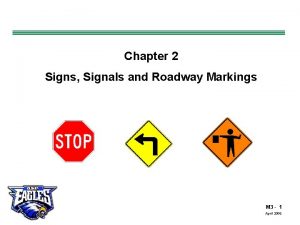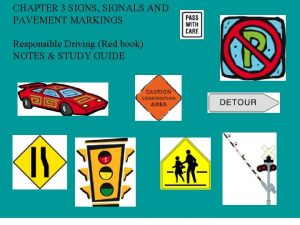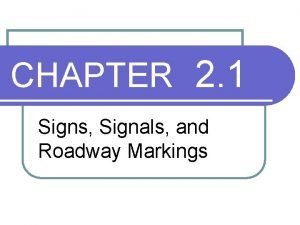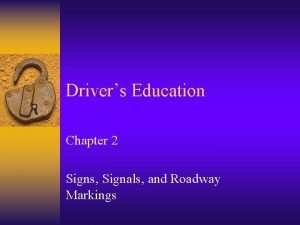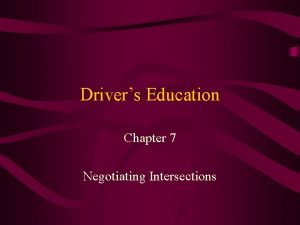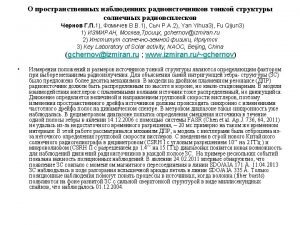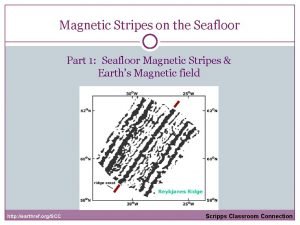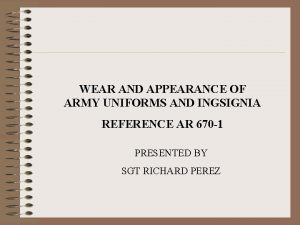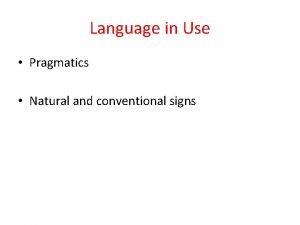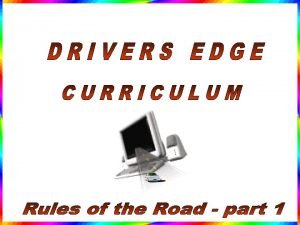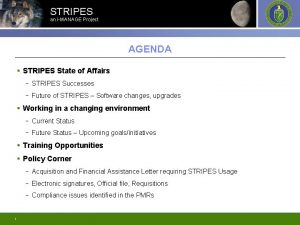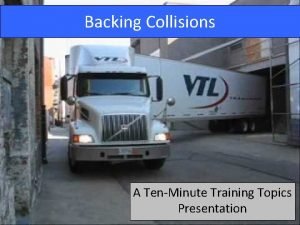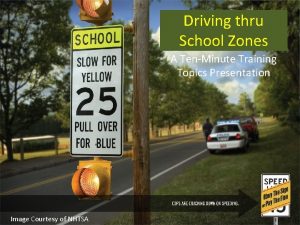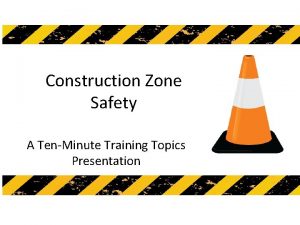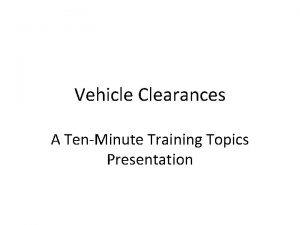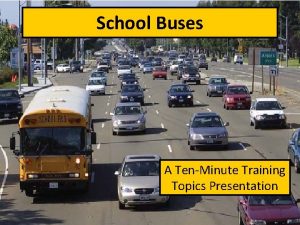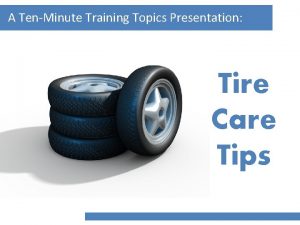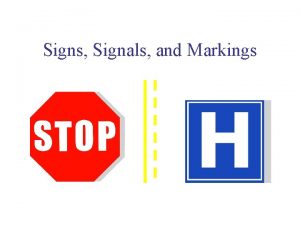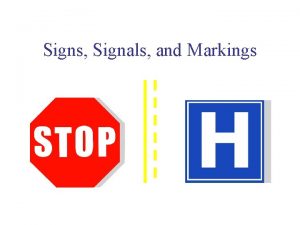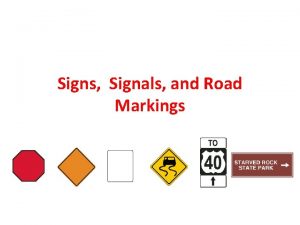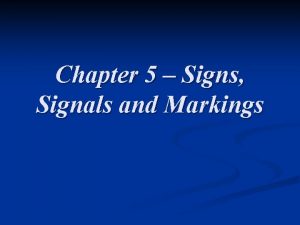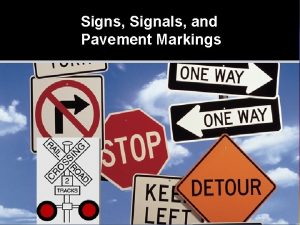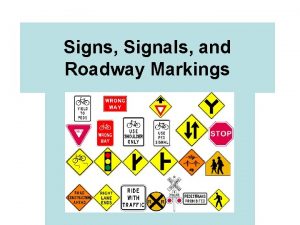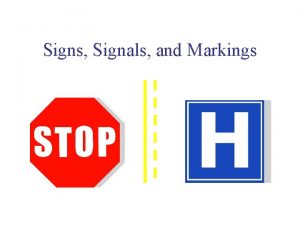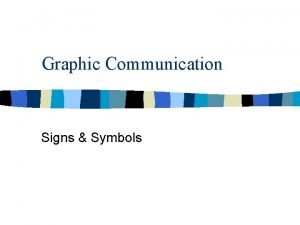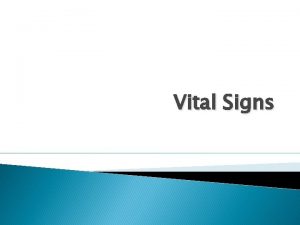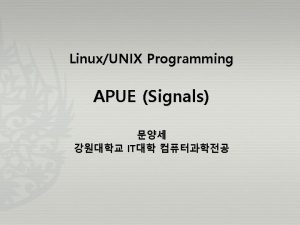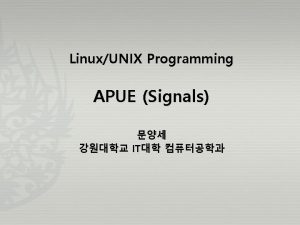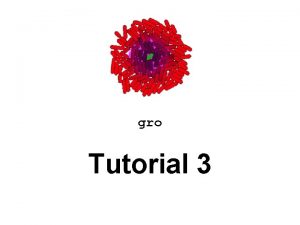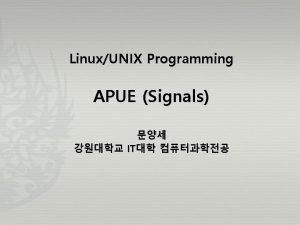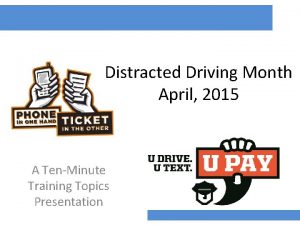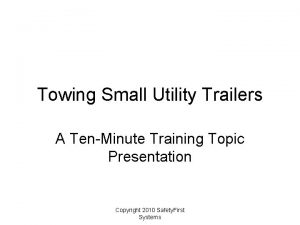Signs Signals and Stripes A TenMinute Training Topics

























- Slides: 25

Signs, Signals and Stripes A Ten-Minute Training Topics Presentation Signs, Signals & Stripes

Statistics • 90% of vehicle crashes are due to driver actions, choices, attitudes or impairment. • Of those collisions, some percentage might have been avoided if the operator had more time to react, or had been more familiar with processes, rules and practices related to successful vehicle operation. Signs, Signals & Stripes

Introduction • While most drivers are familiar with the “rules of the road” based on their early study of driver’s manuals as a teenager first learning to drive, many folks would struggle to pass a “pop quiz” today on those same topics. Signs, Signals & Stripes

Introduction • One of the benefits of adopting a uniform set of rules for traffic safety throughout the USA is that we can travel from state to state without having to learn multiple approaches to regulating traffic flow. • The Manual of Uniform Traffic Control Devices (MUTCD - http: //mutcd. fhwa. dot. gov) establishes consistent guidance for the color, wording, and placement of traffic control signs, signals and stripes. Signs, Signals & Stripes

Introduction • While there may be additional, special issues in local regions that are not universally encountered, most drivers would be able to pick up a driver’s manual from any state in the USA and get 99% of what they need to know presented accurately. Signs, Signals & Stripes

Introduction • Could you imagine if each state had adopted their own standards for traffic safety? We might have triangular, yellow stop signs in one state and purple circles in another! Signs, Signals & Stripes

Refreshers for Everyone • Youthful drivers and newly licensed drivers are two groups that come to mind when thinking about who could benefit from a refresher on signs, signals and stripes. • If you really think about the type of driving observed on today’s highways, there are many more drivers who either don’t understand what these symbols mean, or they simply don’t care. Signs, Signals & Stripes

Refreshers for Everyone • Taking time to become better acquainted with the symbols of the road can help experienced drivers in a number of ways: – better anticipation of conditions ahead based on early recognition of the signs, stripes and signals; – improved reaction times and responsiveness by not having to try to remember and interpret symbols during panic maneuvers. Signs, Signals & Stripes

Refreshers for Everyone • Additionally, it can be helpful when working with less experienced drivers – we want to assure we pass along 100% correct information as we try to encourage them to drive safer. Signs, Signals & Stripes

Signs • The MUTCD covers a lot of detail on signs. Consider this lengthy table of contents listing: – – – Chapter 2 C - Warning Signs and Object Markers Chapter 2 D - Guide Signs for Conventional Roads Chapter 2 E - Guide Signs for Freeways and Expressways Chapter 2 F - Toll Road Signs Chapter 2 G - Preferential and Managed Lane Signs Chapter 2 H - General Information Signs Chapter 2 I - General Service Signs Chapter 2 J - Specific Service (Logo) Signs Chapter 2 K - Tourist-Oriented Directional Signs Chapter 2 L - Changeable Message Signs Chapter 2 M - Recreational and Cultural Interest Area Signs Chapter 2 N - Emergency Management Sign lot or terminal facility. Signs, Signals & Stripes

Signs • The MUTCD provides specific guidance that each local jurisdiction ought to take care in placing signs where they’re really needed and will make a difference. Signs, Signals & Stripes

Signs • Still, it may seem like some signs (deer crossing, etc) are placed randomly – they’re not. • In the case of animal crossing signs (as one example) the signs are placed where there have been prior collisions, or there is a clearly established migration trail. Signs, Signals & Stripes

Signs • Lastly, the MUTCD specifies that signs shall be defined by their function as follows: – Regulatory signs give notice of traffic laws or regulations. – Warning signs give notice of a situation that might not be readily apparent. – Guide signs show route designations, destinations, directions, distances, services, points of interest, and other geographical, recreational, or cultural information Signs, Signals & Stripes

Signals • Traffic signals at intersections help control traffic flow in an orderly and reasonable manner. • They break up heavy traffic flow to allow pauses for pedestrians to cross, and they help to reduce right-angle collisions when properly configured. Signs, Signals & Stripes

Signals • There is a lot of engineering that must be done to best time the signals to maximize traffic flow at various times of the day, and the MUTCD provides a lot of guidance on the selection and set up of signal controlled intersections. Signs, Signals & Stripes

Signals • As motorists we must be careful to pay close attention to signals and treat them “defensively” • In other words, a signal that we first observe to be green may change indication at any time and we ought to be prepared to stop. Signs, Signals & Stripes

Signals • Alternatives to traditional signal controlled intersections may be installed where signals would disrupt traffic flow more than it would benefit. • These may include flashing beacons, stop signs (2 -way or 4 -way) and even roundabouts or “traffic circles”. Signs, Signals & Stripes

Stripes & Lane Markings • Stripes and lane markings on local streets and major highways fulfill specific functions in providing guidance and information for motorists and commercial operators. Signs, Signals & Stripes

Stripes & Lane Markings • Typically encountered markings include lane delineators, merge indicators, curb markings, and in some cases, these are designed to work with other traffic control devices such as signs and signals (i. e. a limit line indicating where to stop along with a stop sign). Signs, Signals & Stripes

Stripes & Lane Markings • The color, pattern (solid versus dashed) and the combination of these factors (one dashed and one solid line have a different meaning that a pair of solid lines) convey different messages to drivers. Signs, Signals & Stripes

Stripes & Lane Markings • Stripes and lane markings confirm passing or no-passing areas, and help us to understand where our vehicle should be in relation to other vehicles which may be going the same direction or may be opposing us. Signs, Signals & Stripes

Summary • It has often been said that the real test of understanding is being able to explain concepts, rules or details to another person so effectively that they also gain an understanding of those details. Signs, Signals & Stripes

Summary • We tend to drive on “auto pilot” each day since we have become familiar with the many types of Signs, Stripes and Signals encountered on side streets and highways. Signs, Signals & Stripes

Summary • However, there’s a benefit to pulling out the local driver’s manual (typically available online for free) to refresh our understanding of these symbols and their intended benefit to drivers. Signs, Signals & Stripes

This presentation was developed by Safety. First and is intended for the specific use and benefit of its clients. Receipt and/or possession of this slideshow does not convey any rights to re-distribute any of its content beyond the recipient’s purview and the organization conducting business directly with Safety. First Systems, LLC. Additionally, neither this presentation nor its supportive resources can be used to create derivative works for any purpose without the express permission of Safety. First Systems. Questions regarding the proper use of this or related documents can be addressed by contacting Safety. First at 1 -888 -603 -6987. Signs, Signals & Stripes
 Signs signs everywhere signs meaning
Signs signs everywhere signs meaning Animals and human language chapter 2
Animals and human language chapter 2 Duality in linguistics
Duality in linguistics Communicative signals and informative signals
Communicative signals and informative signals Is slower traffic keep right a regulatory sign
Is slower traffic keep right a regulatory sign Signs signals and roadway markings
Signs signals and roadway markings Diamond shaped yellow sign with black markings
Diamond shaped yellow sign with black markings Signs signals and pavement markings
Signs signals and pavement markings Chapter 2 signs signals and roadway markings answer key
Chapter 2 signs signals and roadway markings answer key A short section of corrugated roadway
A short section of corrugated roadway People types and tiger stripes
People types and tiger stripes An uncontrolled railroad crossing
An uncontrolled railroad crossing Why did the chicken cross the road stripes
Why did the chicken cross the road stripes Mateusz szymura uwr
Mateusz szymura uwr Zebras adaptations
Zebras adaptations How the whale got his throat comprehension questions
How the whale got his throat comprehension questions Zebra analogy
Zebra analogy Magnetic stripes on the seafloor
Magnetic stripes on the seafloor He stalks in his vivid stripes poem
He stalks in his vivid stripes poem Definisi jalur gemilang
Definisi jalur gemilang Diamante poem definition
Diamante poem definition He should be lurking in shadow
He should be lurking in shadow Army skill badges placement on ocp
Army skill badges placement on ocp Difference between natural and conventional signs
Difference between natural and conventional signs What color means motorist services guidance
What color means motorist services guidance The octagon shape is used exclusively for
The octagon shape is used exclusively for




